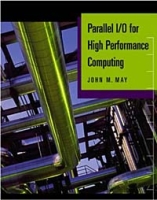| Parallel I/O for High Performance Computing артикул 2534e. |
 |
Suitable for the scientific researcher, computer-science student, or anyone else who might be interested in high-end computers, Parallel I/O for High-Performance Computing is a remarkably clear guide to recent research and expertise in parallelcomputing, and centers on ways for computers to process very large data sets more efficiently озщжэ Although the title makes it sound as if its focus were very narrow, this book delivers an engaging glimpse into the world of serious, high-end scientific computing It begins with a thorough tour of the issues that surround data storage (The author writes clearly and meticulously, and describes trends in data storage, from disk drives and RAID technology to newer developments, like holographic data-storage systems ) Standards that are used by parallel computers to connect to data storage in parallel architectures are surveyed; also, there's extensive coverage of parallel file systems that have attempted to solve the problem of accessing terabytes of information at high speeds, for simulations and forecasting applications This book is very good at describing and summarizing a host of standards that have been developed by both academic and corporate researchers For the working scientific programmer, sections that look at specific APIs for fast parallel I/O perhaps will be more immediately useful There's coverage of MPI-IO, HPF I/O, and SIO LLAPI (three possible standards for parallel computing) for optimized file I/O for parallel systems A section on two scientific libraries (NetCDF and HDF) that simplify loading numerical data offers complete sample programs in C, which show these APIs in action The purpose of this book is to expose the reader to the state of the art in high-end parallel computing, and suggest that I/O often is the bottleneck to achieving the best possible performance in scientific software This far-ranging and intelligent guide will benefit any academic or scientific programmer, as well as anyone who wants to understand the fascinating world of high-end parallel systems that are used for simulations and serious number crunching --Richard Dragan Topics covered: Overview of high-performance I/O requirements Trends in I/O performance I/O levels (RAID technology, parallel file systems) Storage devices (primary, secondary, and tertiary storage) Magnetic disk drives Disk performance Magnetic tape Optical disks Parallelism and I/O requirements In-depth introduction to RAID Interconnect standards: SCSI, High-Performance Parallel Interface (HIPPI), Gigabyte System Network (GSN), Fibre Channel, and message-passing networks Network-attached storage devices Holographic storage Unixfile system Fault-tolerance and journaling Distributed file systems (DFS) Sun's Network File System (NFS) Shared-memory computer design and architecture Distributed-memory computers Parallel file systems: Intel Parallel File System (PFS), Parallel I/O File System (PIOFS), and General Parallel File System (GPFS) High-Performance File System (HPFS) Cluster file systems: XFS, Parallel Virtual File System (PVFS), and Berkeley River Review of studies on I/O access patterns for scientific software Collective I/O and performance Two-phase I/O Server-based collective I/O Disk-directed I/O (DDIO) Hints and automatic adaptation Research projects for improved parallel I/O Portable Parallel File Systems (PPFS) Panda Programming with low-level I/O APIs: MPI-IO, HPF I/O, and SIO Low-Level API (LLAPI) Scientific libraries for processing numerical data (NetCDF version 3 4 and HDF version 5) Sample code for readingand writing numerical data Fiber bundles for representing number data Out-of-core computations and algorithms Virtual memory Compiler-directed file layout Checkpointing techniques and libraries Data management and analysis Scientific databases (relational and object-oriented) Knowledge discovery and data mining for research applications. Издание 1988ISBN 1558606645. |